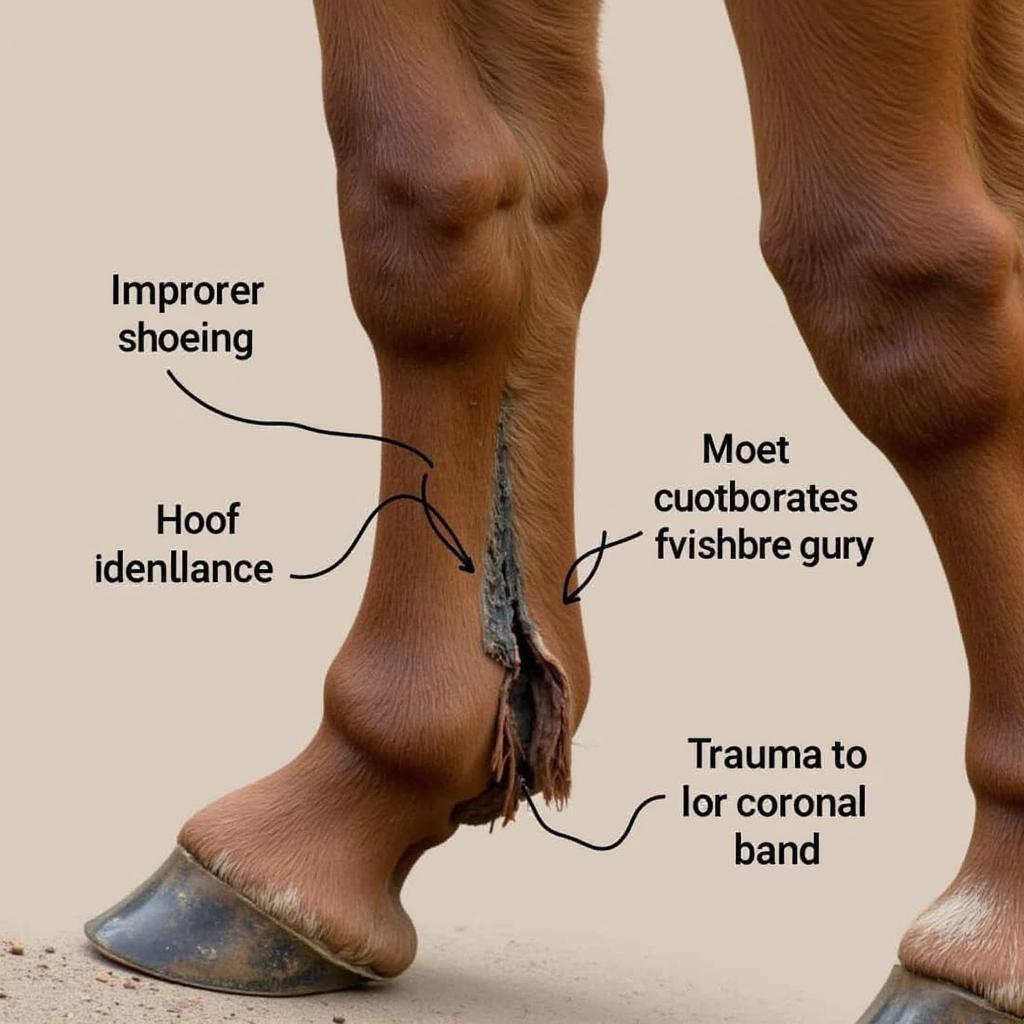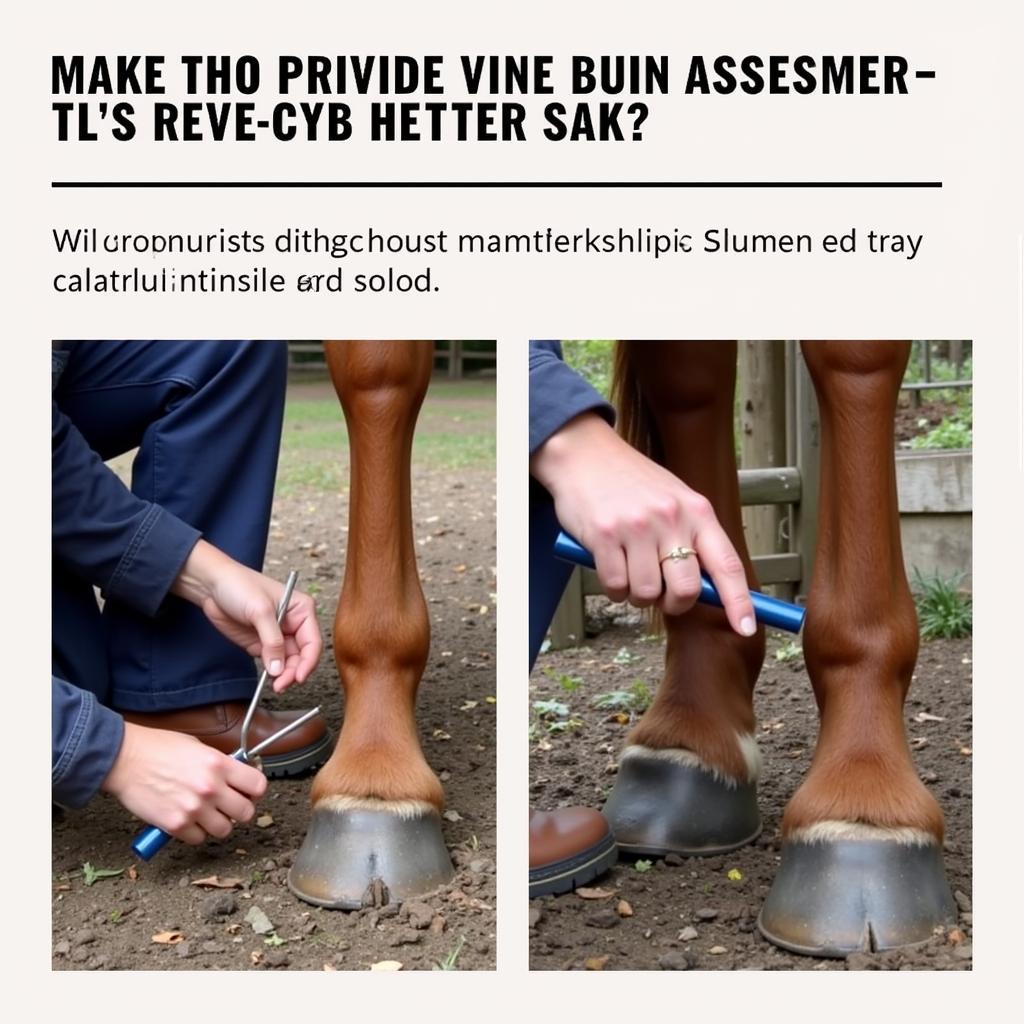A quarter crack is a common hoof problem in horses, characterized by a vertical crack in the hoof wall. It usually originates at the coronary band, the band of tissue above the hoof, and extends downward toward the shoe. While the sight of a quarter crack can be concerning, understanding its causes, treatment, and prevention can help you ensure your horse’s hoof health and soundness.
What Causes a Quarter Crack in a Horse?
Several factors contribute to quarter cracks, and often, it’s a combination of issues rather than a single cause. Some of the most common culprits include:
- Improper Shoeing: Poor shoeing practices, such as shoes that are too short or long, uneven pressure on the hoof wall, or incorrect nail placement, can create stress points that lead to cracks.
- Hoof Imbalance: If the horse’s hoof is imbalanced, with one side growing faster or longer than the other, it can put uneven pressure on the hoof wall, making it susceptible to cracking.
- Dry and Brittle Hooves: Just like our nails, horses’ hooves need adequate moisture to stay strong and flexible. Dry conditions, nutritional deficiencies, or underlying health conditions can lead to brittle hooves that are more prone to cracking.
- Trauma or Injury: A direct blow to the coronary band or excessive stress from activities like jumping or fast work can also cause a quarter crack.
 Close-up of a quarter crack on a horse hoof, showcasing common causes
Close-up of a quarter crack on a horse hoof, showcasing common causes
Recognizing the Signs of a Quarter Crack
Early detection is crucial for effective treatment. Here’s what to look out for:
- Visible Crack: A vertical crack in the hoof wall, typically starting at the coronary band.
- Sensitivity: Your horse might show signs of lameness, especially on hard surfaces or during turns.
- Swelling or Discharge: The area around the crack might be swollen, warm to the touch, or have a foul-smelling discharge, indicating infection.
- Changes in Gait: You might notice your horse favoring a leg or altering its gait to avoid putting pressure on the affected hoof.
Treating Quarter Cracks: A Step-by-Step Approach
If you suspect your horse has a quarter crack, it’s essential to contact your veterinarian or a qualified farrier immediately. They can assess the severity of the crack and recommend the best course of treatment, which may include:
-
Stabilizing the Crack: The first step is to stabilize the crack and prevent it from widening. This might involve:
- Shoeing Modifications: Your farrier can apply special shoes or techniques to redistribute pressure away from the crack and promote healing.
- Acrylic Patches: An acrylic patch can be applied across the crack to provide support and prevent further separation.
- Screws or Wires: In more severe cases, screws or wires may be used to hold the hoof wall together.
-
Addressing Underlying Issues: Identifying and addressing any underlying causes, such as hoof imbalance or nutritional deficiencies, is crucial for long-term success.
-
Managing Infection: If the crack is infected, your veterinarian will prescribe antibiotics or other medications to clear the infection.
 A veterinarian carefully examining a horse's hoof with a quarter crack
A veterinarian carefully examining a horse's hoof with a quarter crack
Prevention is Key: Keeping Your Horse’s Hooves Healthy
Preventing quarter cracks involves proactive hoof care practices:
- Regular Farrier Visits: Schedule regular farrier appointments (every 6-8 weeks) to ensure proper hoof balance and trimming.
- Balanced Diet: Provide a balanced diet rich in essential nutrients like biotin, zinc, and copper, which contribute to healthy hoof growth.
- Proper Moisture: Maintain adequate moisture in your horse’s hooves, especially during dry seasons. Use hoof moisturizers if needed.
- Early Detection: Regularly inspect your horse’s hooves for any signs of cracks, abnormalities, or discomfort.
Quarter Crack Horse Hoof: A Common Concern with Effective Solutions
While quarter cracks can be a significant problem for horses, understanding the causes, recognizing the signs, and seeking prompt professional treatment can help ensure a positive outcome. Proactive hoof care and management are essential for preventing this common condition and keeping your equine partner happy and sound.
FAQs about Quarter Cracks in Horses
Q: How long does it take for a quarter crack to heal?
A: Healing time varies depending on the severity of the crack and the horse’s overall health. It can take several months to a year for a quarter crack to fully heal.
Q: Can a horse with a quarter crack be ridden?
A: It depends on the severity of the crack and your veterinarian’s recommendation. In some cases, light riding might be possible with proper shoeing and management. However, rest is often necessary during the initial healing phase.
Q: Is a quarter crack painful for a horse?
A: Yes, quarter cracks can be painful, especially if they are deep, infected, or putting pressure on sensitive structures within the hoof.
Q: Can I treat a quarter crack myself?
A: It’s crucial to consult with a veterinarian or qualified farrier for diagnosis and treatment. Attempting to treat a quarter crack yourself can worsen the condition or lead to complications.
Q: What are the chances of a quarter crack recurring?
A: Quarter cracks can recur, especially if the underlying causes are not addressed. Proactive hoof care and management are crucial for minimizing the risk of recurrence.
Need help with a suspected quarter crack horse hoof or other hoof issues? Our team at Justus Horses USA is here to provide expert advice and resources to help keep your horse’s hooves healthy and strong.
Explore our website for more informative articles on what are bell boots for horses used for, horse window stickers, full body horse sleazy, or check out our listings for used horse trailers for sale in Ohio.
For personalized assistance, contact us at Phone Number: 0772127271, Email: [email protected] Or visit us at: QGM2+WX2, Vị Trung, Vị Thuỷ, Hậu Giang, Việt Nam. Our customer care team is available 24/7 to address your concerns.